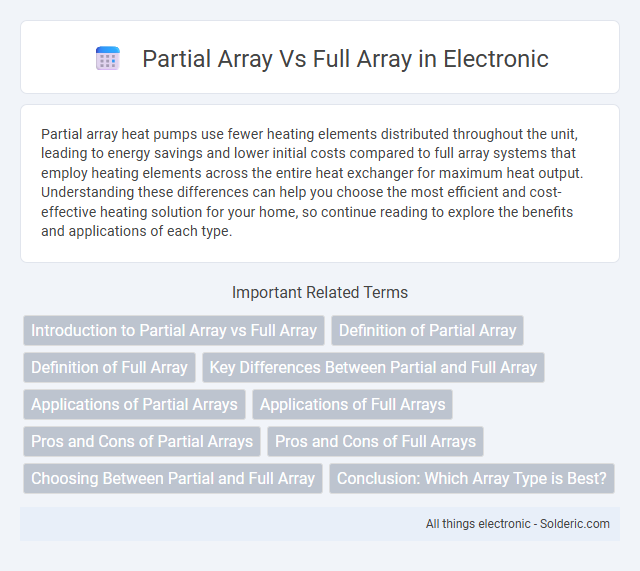Partial array heat pumps use fewer heating elements distributed throughout the unit, leading to energy savings and lower initial costs compared to full array systems that employ heating elements across the entire heat exchanger for maximum heat output. Understanding these differences can help you choose the most efficient and cost-effective heating solution for your home, so continue reading to explore the benefits and applications of each type.
Comparison Table
| Feature | Partial Array | Full Array |
|---|---|---|
| Definition | Array that holds a subset of elements from a larger array. | Array that contains all elements from the original dataset or structure. |
| Memory Usage | Lower memory consumption due to fewer elements stored. | Higher memory consumption, storing complete data set. |
| Performance | Faster access when working with focused data segments. | Slower performance for large data due to full traversal. |
| Use Case | Suitable for operations on limited or segmented data. | Ideal for comprehensive data processing or manipulation. |
| Complexity | Lower complexity, easier management of subset. | Higher complexity due to size and full data handling. |
Introduction to Partial Array vs Full Array
Partial array LED displays feature LED modules arranged in specific sections, offering cost-effective solutions with limited coverage areas, whereas full array LED displays provide a continuous, seamless surface of LEDs covering the entire display area for better uniformity and brightness. Your choice between partial and full array depends on factors like budget, application size, and desired image quality. Full arrays are ideal for professional settings demanding high resolution and consistent brightness, while partial arrays suit smaller or segmented displays.
Definition of Partial Array
A partial array refers to an array in which only a portion of the allocated elements are initialized or actively used, while the rest remain undefined or set to default values. Unlike a full array, where all elements contain meaningful data, a partial array often results from data processing scenarios where only a subset of elements is relevant at any point in time. This concept is crucial in optimizing memory usage and improving computational efficiency in programming and algorithm design.
Definition of Full Array
Full array TV backlighting uses a grid of LEDs spread evenly behind the entire screen, providing consistent brightness and superior contrast compared to edge-lit or partial array displays. This type of backlighting enables local dimming, where specific zones can be dimmed or brightened independently to enhance black levels and overall picture quality. Your viewing experience benefits from improved color accuracy and deeper blacks, especially in dark scenes.
Key Differences Between Partial and Full Array
Partial array batteries have inactive cells or unused segments, leading to lower capacity and reduced performance compared to full array batteries, which utilize all cells for maximum power output. Full array systems provide consistent voltage and longer runtime by fully employing every cell in the battery pack, while partial arrays may experience voltage drops and uneven wear due to cell imbalance. The key difference lies in efficiency and reliability, with full arrays delivering optimal energy utilization and partial arrays often serving as a cost-saving compromise with diminished overall capability.
Applications of Partial Arrays
Partial arrays are commonly used in embedded systems and memory-constrained devices where minimizing power consumption and silicon area is critical. They enable selective activation of memory sections, improving efficiency in applications such as cache memories, SRAM blocks, and specialized signal processing units. This targeted access reduces leakage power and enhances performance in portable electronics and IoT devices.
Applications of Full Arrays
Full arrays are widely used in applications requiring uniform illumination and precise light control, such as large LED video walls, architectural lighting, and medical imaging displays. These arrays enable consistent brightness and color accuracy across extensive surfaces, enhancing visual impact and functional performance. Your projects benefit from full arrays when seamless, high-resolution light distribution is critical.
Pros and Cons of Partial Arrays
Partial arrays offer enhanced local dimming control, improving contrast and black levels compared to edge-lit displays, which benefits your viewing experience by delivering deeper blacks and reduced light bleed. They tend to be more cost-effective and energy-efficient than full array backlights, although their dimming zones are limited, which can lead to less precise brightness and contrast adjustments. Partial arrays provide a balanced choice for high-quality picture performance without the higher price or power consumption of full array designs.
Pros and Cons of Full Arrays
Full arrays offer superior image quality with deeper contrast and wider viewing angles due to their uniform LED backlighting spread across the entire screen. The main drawback is higher energy consumption and cost compared to partial arrays, as the increased number of LEDs requires more power and advanced heat management. Your choice depends on prioritizing picture quality versus budget and energy efficiency.
Choosing Between Partial and Full Array
Choosing between partial and full array depends on specific use cases, budget, and desired performance. Partial arrays provide targeted coverage with lower costs and reduced complexity, ideal for focused environments or phased upgrades. Full arrays ensure comprehensive data visibility and redundancy, suitable for critical applications requiring complete system monitoring and fault tolerance.
Conclusion: Which Array Type is Best?
Full array TVs typically offer better contrast and more uniform brightness by using a dense grid of local dimming zones, enhancing picture quality for darker scenes. Partial array displays have fewer dimming zones, which can lead to less precise control over brightness and contrast but often come at a lower cost. Your choice depends on whether you prioritize superior image performance or budget considerations.
Partial Array vs Full Array Infographic

 solderic.com
solderic.com